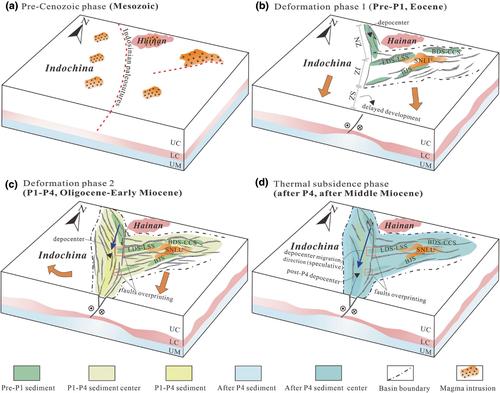当前位置:
X-MOL 学术
›
Basin Res.
›
论文详情
Our official English website, www.x-mol.net, welcomes your
feedback! (Note: you will need to create a separate account there.)
New insights into the structure of the Yinggehai Basin and its tectonic implications, South China Sea: Evidence from scaled physical models
Basin Research ( IF 2.8 ) Pub Date : 2024-07-24 , DOI: 10.1111/bre.12888 Gengxiong Yang 1 , Hongwei Yin 1 , Dong Jia 1 , Hongbin Wang 2 , Wei Wang 1 , Wenqiao Xu 1
Basin Research ( IF 2.8 ) Pub Date : 2024-07-24 , DOI: 10.1111/bre.12888 Gengxiong Yang 1 , Hongwei Yin 1 , Dong Jia 1 , Hongbin Wang 2 , Wei Wang 1 , Wenqiao Xu 1
Affiliation

|
The Yinggehai Basin is situated at the junction of Indochina and the northern South China Sea (SCS). The origin of the Yinggehai Basin is generally believed to be controlled by the rotation of the Indochina block along the Red River shear zone (RRSZ), which was formed by the collision of India with Asia during the Oligocene. However, the Eocene structural mechanisms of this basin remain debatable. Some studies suggest that the Eocene reactivation of the palaeo‐suture zone (which serves as a precursor to the RRSZ) has influenced the region. In contrast, others propose that the NNW–SSE extension of the northern SCS caused by the subduction of the palaeo‐SCS towards Borneo in the Eocene has played a significant role. To address these controversies, our study takes into account these two crucial factors using physical analogue modelling. The experimental results, including slow sinistral strike‐slip along the palaeo‐suture zone and the adjacent NNW–SSE extension, successfully explain the observed fault pattern during the Eocene period. It is noteworthy that the former primarily controlled the Eocene structure in the northern region of the Yinggehai Basin, whereas the latter played a pivotal role in shaping the ENE–WSW Eocene structures on the eastern slope of the basin. The westward propagating faults of the Qiongdongnan basin are cut off by the Yinggehai Basin structures at later large‐scale rotation stage. The experiment indicates that the basin evolution exhibits diachronous characteristics, with subsidence in the south occurring later than in the north. Our modelling results provide valuable insights into the key controlling factors that shaped the evolution of the basin during each stage. Furthermore, our findings offer evidence of the interaction between two significant tectonic processes: Indochina extrusion and the opening of the SCS.
中文翻译:

对南海莺歌海盆地结构及其构造意义的新认识:来自比例物理模型的证据
莺歌海盆地位于印度支那和南海北部的交界处。莺歌海盆地的起源一般认为是受印度支那地块沿红河剪切带(RRSZ)的旋转控制,红河剪切带是渐新世印度与亚洲碰撞形成的。然而,该盆地的始新世构造机制仍存在争议。一些研究表明,始新世古缝合带(作为 RRSZ 的前身)的重新激活影响了该地区。相比之下,其他人则认为,始新世古南海向婆罗洲俯冲而引起的南海北部北北西—南南东延伸发挥了重要作用。为了解决这些争议,我们的研究使用物理模拟建模考虑了这两个关键因素。实验结果,包括沿古缝合带和邻近的 NNW-SSE 延伸的缓慢左旋走滑,成功地解释了始新世时期观察到的断层模式。值得注意的是,前者主要控制莺歌海盆地北部地区的始新世构造,而后者则对盆地东斜坡ENE—WSW始新世构造的形成起到了关键作用。琼东南盆地向西传播的断裂在大规模旋转后期被莺歌海盆地构造切断。实验表明,盆地演化呈现出南方沉降晚于北方的穿时特征。我们的建模结果为了解每个阶段形成盆地演化的关键控制因素提供了宝贵的见解。 此外,我们的研究结果提供了两个重要构造过程之间相互作用的证据:印度支那挤压和南海开放。
更新日期:2024-07-24
中文翻译:

对南海莺歌海盆地结构及其构造意义的新认识:来自比例物理模型的证据
莺歌海盆地位于印度支那和南海北部的交界处。莺歌海盆地的起源一般认为是受印度支那地块沿红河剪切带(RRSZ)的旋转控制,红河剪切带是渐新世印度与亚洲碰撞形成的。然而,该盆地的始新世构造机制仍存在争议。一些研究表明,始新世古缝合带(作为 RRSZ 的前身)的重新激活影响了该地区。相比之下,其他人则认为,始新世古南海向婆罗洲俯冲而引起的南海北部北北西—南南东延伸发挥了重要作用。为了解决这些争议,我们的研究使用物理模拟建模考虑了这两个关键因素。实验结果,包括沿古缝合带和邻近的 NNW-SSE 延伸的缓慢左旋走滑,成功地解释了始新世时期观察到的断层模式。值得注意的是,前者主要控制莺歌海盆地北部地区的始新世构造,而后者则对盆地东斜坡ENE—WSW始新世构造的形成起到了关键作用。琼东南盆地向西传播的断裂在大规模旋转后期被莺歌海盆地构造切断。实验表明,盆地演化呈现出南方沉降晚于北方的穿时特征。我们的建模结果为了解每个阶段形成盆地演化的关键控制因素提供了宝贵的见解。 此外,我们的研究结果提供了两个重要构造过程之间相互作用的证据:印度支那挤压和南海开放。






























 京公网安备 11010802027423号
京公网安备 11010802027423号